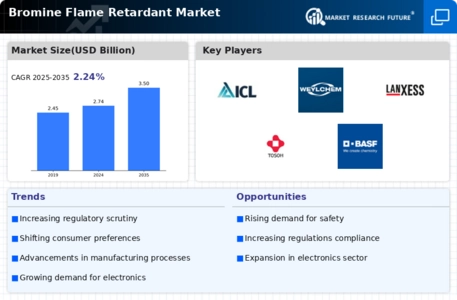Rising Awareness of Fire Safety
There is a growing awareness of fire safety among consumers and industries, which is significantly influencing the Bromine Flame Retardant Market. As incidents of fire-related accidents continue to garner attention, stakeholders are increasingly prioritizing the incorporation of fire-resistant materials in their products. This heightened awareness is particularly evident in sectors such as automotive, electronics, and construction, where the implications of fire safety are paramount. The market for bromine flame retardants is likely to benefit from this trend, as manufacturers seek to enhance the safety profiles of their products to meet consumer expectations and regulatory demands.
Increasing Demand from Electronics Sector
The Bromine Flame Retardant Market is experiencing a notable surge in demand, particularly from the electronics sector. As electronic devices become more ubiquitous, the need for materials that can withstand high temperatures and resist ignition is paramount. Bromine flame retardants are increasingly utilized in circuit boards, cables, and other components to enhance safety and compliance with stringent regulations. The electronics industry is projected to grow at a compound annual growth rate of approximately 5% over the next few years, further driving the demand for bromine-based solutions. This trend indicates a robust market potential for bromine flame retardants, as manufacturers seek to meet both safety standards and consumer expectations for reliable, fire-resistant products.
Growth in Construction and Building Materials
The construction sector plays a pivotal role in the Bromine Flame Retardant Market, as the demand for fire-resistant materials in building applications continues to rise. With increasing urbanization and infrastructure development, the need for safe building materials is more critical than ever. Bromine flame retardants are widely used in insulation materials, roofing, and wall coverings to enhance fire safety. The construction industry is anticipated to expand significantly, with estimates suggesting a growth rate of around 4% annually. This growth is likely to bolster the demand for bromine flame retardants, as builders and architects prioritize safety and compliance with fire regulations in their projects.
Regulatory Pressures and Compliance Requirements
Regulatory pressures are a driving force in the Bromine Flame Retardant Market, as governments worldwide implement stringent safety standards for fire safety in various applications. Compliance with these regulations is essential for manufacturers, prompting them to incorporate bromine flame retardants into their products. The increasing focus on fire safety in sectors such as automotive, textiles, and construction is likely to propel the demand for bromine-based solutions. As regulations evolve, companies are compelled to adapt their product formulations, which may lead to a sustained increase in the consumption of bromine flame retardants to meet compliance requirements.
Technological Innovations in Flame Retardant Formulations
Technological innovations are reshaping the Bromine Flame Retardant Market, as manufacturers develop advanced formulations that enhance the efficacy and safety of bromine-based solutions. Research and development efforts are focused on creating flame retardants that not only meet regulatory standards but also minimize environmental impact. Innovations such as the development of non-halogenated alternatives and improved application techniques are likely to expand the market. As industries seek to balance performance with sustainability, the demand for innovative bromine flame retardants is expected to rise, reflecting a shift towards more responsible and effective fire safety solutions.

















Leave a Comment